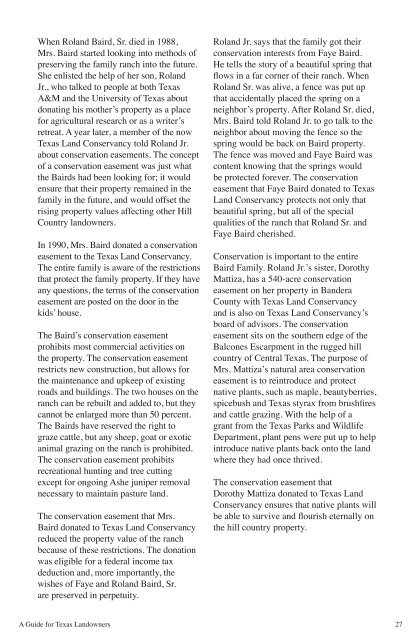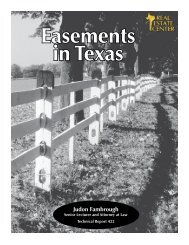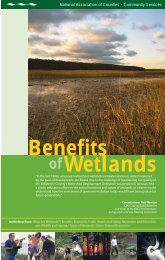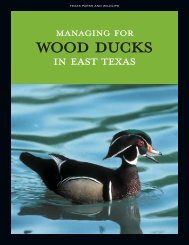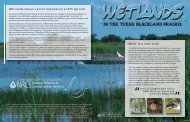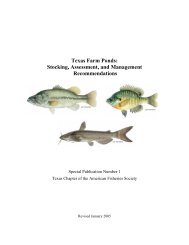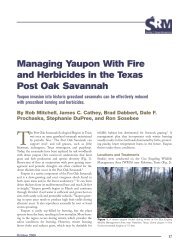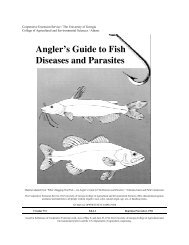Conservation Easements, A Guide for Texas Landowners
Conservation Easements, A Guide for Texas Landowners
Conservation Easements, A Guide for Texas Landowners
You also want an ePaper? Increase the reach of your titles
YUMPU automatically turns print PDFs into web optimized ePapers that Google loves.
When Roland Baird, Sr. died in 1988,<br />
Mrs. Baird started looking into methods of<br />
preserving the family ranch into the future.<br />
She enlisted the help of her son, Roland<br />
Jr., who talked to people at both <strong>Texas</strong><br />
A&M and the University of <strong>Texas</strong> about<br />
donating his mother’s property as a place<br />
<strong>for</strong> agricultural research or as a writer’s<br />
retreat. A year later, a member of the now<br />
<strong>Texas</strong> Land Conservancy told Roland Jr.<br />
about conservation easements. The concept<br />
of a conservation easement was just what<br />
the Bairds had been looking <strong>for</strong>; it would<br />
ensure that their property remained in the<br />
family in the future, and would offset the<br />
rising property values affecting other Hill<br />
Country landowners.<br />
In 1990, Mrs. Baird donated a conservation<br />
easement to the <strong>Texas</strong> Land Conservancy.<br />
The entire family is aware of the restrictions<br />
that protect the family property. If they have<br />
any questions, the terms of the conservation<br />
easement are posted on the door in the<br />
kids’ house.<br />
The Baird’s conservation easement<br />
prohibits most commercial activities on<br />
the property. The conservation easement<br />
restricts new construction, but allows <strong>for</strong><br />
the maintenance and upkeep of existing<br />
roads and buildings. The two houses on the<br />
ranch can be rebuilt and added to, but they<br />
cannot be enlarged more than 50 percent.<br />
The Bairds have reserved the right to<br />
graze cattle, but any sheep, goat or exotic<br />
animal grazing on the ranch is prohibited.<br />
The conservation easement prohibits<br />
recreational hunting and tree cutting<br />
except <strong>for</strong> ongoing Ashe juniper removal<br />
necessary to maintain pasture land.<br />
The conservation easement that Mrs.<br />
Baird donated to <strong>Texas</strong> Land Conservancy<br />
reduced the property value of the ranch<br />
because of these restrictions. The donation<br />
was eligible <strong>for</strong> a federal income tax<br />
deduction and, more importantly, the<br />
wishes of Faye and Roland Baird, Sr.<br />
are preserved in perpetuity.<br />
Roland Jr. says that the family got their<br />
conservation interests from Faye Baird.<br />
He tells the story of a beautiful spring that<br />
flows in a far corner of their ranch. When<br />
Roland Sr. was alive, a fence was put up<br />
that accidentally placed the spring on a<br />
neighbor’s property. After Roland Sr. died,<br />
Mrs. Baird told Roland Jr. to go talk to the<br />
neighbor about moving the fence so the<br />
spring would be back on Baird property.<br />
The fence was moved and Faye Baird was<br />
content knowing that the springs would<br />
be protected <strong>for</strong>ever. The conservation<br />
easement that Faye Baird donated to <strong>Texas</strong><br />
Land Conservancy protects not only that<br />
beautiful spring, but all of the special<br />
qualities of the ranch that Roland Sr. and<br />
Faye Baird cherished.<br />
<strong>Conservation</strong> is important to the entire<br />
Baird Family. Roland Jr.’s sister, Dorothy<br />
Mattiza, has a 540-acre conservation<br />
easement on her property in Bandera<br />
County with <strong>Texas</strong> Land Conservancy<br />
and is also on <strong>Texas</strong> Land Conservancy’s<br />
board of advisors. The conservation<br />
easement sits on the southern edge of the<br />
Balcones Escarpment in the rugged hill<br />
country of Central <strong>Texas</strong>. The purpose of<br />
Mrs. Mattiza’s natural area conservation<br />
easement is to reintroduce and protect<br />
native plants, such as maple, beautyberries,<br />
spicebush and <strong>Texas</strong> styrax from brushfires<br />
and cattle grazing. With the help of a<br />
grant from the <strong>Texas</strong> Parks and Wildlife<br />
Department, plant pens were put up to help<br />
introduce native plants back onto the land<br />
where they had once thrived.<br />
The conservation easement that<br />
Dorothy Mattiza donated to <strong>Texas</strong> Land<br />
Conservancy ensures that native plants will<br />
be able to survive and flourish eternally on<br />
the hill country property.<br />
A <strong>Guide</strong> <strong>for</strong> <strong>Texas</strong> <strong>Landowners</strong><br />
27


